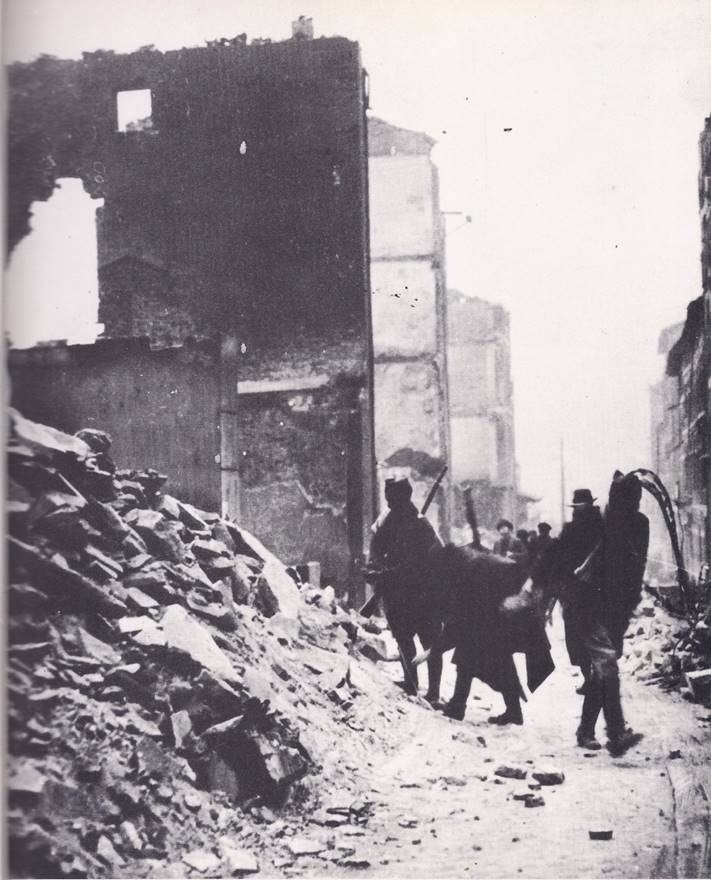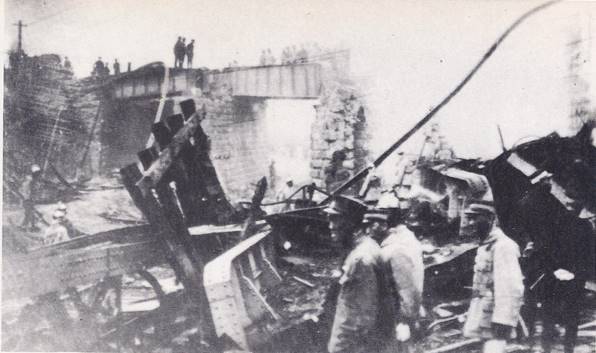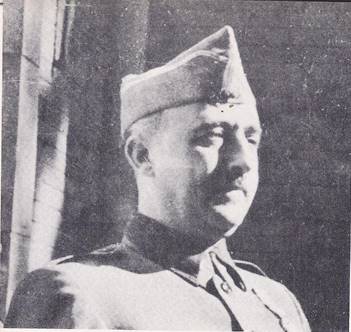THE END OF World War I brought many changes of government in Europe, but in a number of countries the old aristocrats and landowners still had power and the new governments could not solve the problems that faced them. Among these countries was Poland. A democratic form of government had been established, but conflicts between various parties and their leaders kept it from being very effective.
General Joseph Pilsudski had helped to set up the new government of Poland. He retired from public office in 1922, when Poland adopted a democratic constitution. Pilsudski wanted a bigger and stronger Poland and he was dissatisfied with what the government was doing. In 1926 he led his armed followers on Warsaw, the nation’s capital and the tramp of marching men sounded in Poland, as it did in Italy and Germany. Within a few days, Pilsudski was in control of the government. Although from time to time he held various offices in the government, Pilsudski was really the dictator of Poland until his death in 1935.
Shortly before he died, Pilsudski put through a new constitution. While it called for certain democratic procedures, such as the election of a parliament, it merely made official Pilsudski’s military dictatorship. Pilsudski’s place was taken by General Edward Smigly-Rydz, the inspector-general of the army. He ruled with the aid of a group of military men known as the “colonels.” Although Poland’s political organization was looser than that of Germany or Italy, its form of government was very close to fascism.
Much the same thing was true in the countries of the Balkans — in Greece, Yugoslavia, Albania, Bulgaria and Rumania. During the 1920’s and early 1930’s Greece tried various forms of government. It was at times a monarchy, at times a dictatorship and at times a democratic republic. In 1936, however, King George named General John Metaxas as head of the government.
Metaxas did away with elections and the National Assembly and he ruled as a dictator until 1941.
Yugoslavia was also a monarchy, but Peter II, who became king in 1935, was too young to rule. A regency was set up, headed by Prince Paul Karageorgevich. Although Yugoslavia had a parliament, it was under the control of the regency and the government party.
Albania, Bulgaria and Rumania were all monarchies in which the king set up a royal dictatorship. In 1959, however, Mussolini drove out Albania’s king and took over the rule of that small country. In Rumania, the government was menaced by the Iron Guard, a fascist party which had the support of Nazi Germany.
In Portugal, in the southwest corner of Europe, a military dictatorship took over the government. Beginning in 1928, Antonio de Oliveira Salazar, a university professor, became the most important figure in the country. In 1933, under a new constitution, Salazar set up a strict dictatorship that held Portugal in a firm grip.

It was Portugal’s neighbour, Spain, which attracted the attention of the world. During the years immediately following World War I, Spain had a constitutional monarchy, with King Alfonso on the throne. Socialists and other radicals, however, were beginning to win influence over the people and there were a number of strikes and riots. To make things even worse, Spain was having trouble in Spanish Morocco, the territory it held in Africa. Troops were sent to that region to put down the native Riffs, who were led by the chieftain Abd-el-Krim. In 1921, the Riffs trapped a Spanish force of 20,000 men, killing 12,000 of them.
Shocked by this disaster, the Spanish people became even more restless. To control them, King Alfonso allowed General Miguel Primo de Rivera to become military dictator in 1923. Rivera was not very successful and finally, in 1930, he resigned. Although Alfonso promised the people more rights, they had turned against him and refused to be satisfied with promises. Crowds gathered in the streets, shouting, “Down with the king! Down with the monarchy!” A year later, the king was forced to flee and a republic was established. The new government confiscated property belonging to the aristocrats and the Catholic Church and put through a number of reforms.
While a majority of the people supported the republic, Spain was a divided country. The Socialists, the Communists and another group of radicals, the syndicalists, all gave support to the republic, but they all demanded further and more drastic reforms. Opposed to the republic was a coalition of aristocrats, landowners, industrialists, monarchists and much of the hierarchy of the Catholic Church. Also opposed to the republic was the army — and the army took the lead in rebelling against the government.
The rebellion began in Morocco in July of 1936. Most of the army and almost all of its officers rallied to the Nationalists, as the rebels called themselves. One of their leaders was General Francisco Franco and it was he who would become their head. Soon the rebels were receiving help from Fascist Italy and Nazi Germany –men, arms, ships and planes.
The Loyalists, as the supporters of the republic were called, quickly organized a military and they were able to keep Franco’s army from taking Madrid, the capital city. To strengthen the government, Socialists and Communists were added to the cabinet and a Socialist, Francisco Largo Caballero, became premier. When the Loyalists asked for help from other nations, they were deeply disappointed‚ The United States, Britain and France were afraid that the war might spread to all of Europe. They decided on a policy of “non-intervention” — that is, they refused to help either side. The republic was forced to rely on aid from the Soviet Union, which sold Spain some tanks, planes, supplies and sent some officers. Volunteers from many countries, however, rushed to Spain to fight against fascism in the International Brigades. Among them were Americans who fought under Communist leadership in the Abraham Lincoln Brigade.
Nazi Germany saw in the Spanish civil war a good opportunity to test new weapons and methods of killing. In April of 1937, German planes attacked the historic town of Guernica. They dropped bombs on civilians, including a large number of women, children and destroyed the town. The world — except for the fascists — was horrified. Spain, the romantic land of castles and bullfights, of song and dance, of castanets and guitars, had become the scene of a mass murder — the kind of killing that would be practiced on an even larger scale in World War II.
The people of Spain and the volunteers of the International Brigades fought bravely and well. As the Nationalists pushed on, the Loyalists said, “No paseran” — “they shall not pass,” and “Madrid will be the grave of fascism.” However, they were no match for Franco’s army, backed by men and guns and tanks and planes from Italy and Germany. Besides, the Russians were using their aid to gain power and wipe out the Trotskyites and anti-Communists Loyalists. In March of 1939, Franco marched into Madrid and Spain was no longer a republic. At least 700,000 soldiers had been killed, while 30,000 persons had been executed or assassinated and 15,000 had lost their lives in air raids.
JAPAN EXPANDS
In August of that same year, General Franco proclaimed himself Caudillo, or leader, “responsible only to God and to history.” Spain became a fascist dictatorship with one party and no civil liberties. The story was much the same as it had been in Italy and Germany, except for one thing. In Germany, Hitler controlled the churches and made Nazism into a sort of religion. In Italy, a strongly Catholic country, Mussolini and the Catholic Church were forced to come uneasily to terms. Spain was even more strongly Catholic than Italy and Franco made Catholicism the state religion. Anti-Franco Catholics — including many priests — fled into exile.

Meanwhile, in Asia, another country was living under a dictatorship that had most of the features of fascism. With a large and growing population crowded on the four islands of its homeland, Japan had for long been interested in expansion. After its unexpected victory against Russia in 1905, Japan took its place as one of the military powers of the world. Although Japan had an emperor, real control was in the hands of the military men and the zaibatsu — the family groups that owned the big businesses and industries. Japan needed more land and its leaders were especially tempted by the vast territories of China. During the 1920’s, however, the zaibatsu turned their attention to building up the nation’s industry and democratic ideas began to take hold among the people.
Even so, the militarists remained strong and continued to make plans. In 1927, General Baron Glichi Tanaka was supposed to have sent a report to the emperor which said:
“In the future, if we want to control China, we must first crush the United States just as in the past we had to fight the Russo-Japanese War. But in order to conquer China we must first conquer Manchuria and Mongolia. In order to conquer the world, we must first conquer China. If we succeed in conquering China the rest of the Asian countries and the South Seas countries will fear us and surrender. Then the world will realize that Eastern Asia is ours and will not dare to violate our rights. This is the plan left to us by Emperor Meiji, the success of which is essential to our national existence.”
When news of this reached the outside world, the Japanese government stated that no such report had been made. Nevertheless, the events of the following years proved that the militarists did indeed have a plan of conquest. They gained more strength during the great depression of 1929, which ruined Japan’s Silk industry. To get what they wanted, they even assassinated government officials and by 1931 the militarists were the greatest power in Japan.
That year, too, they were ready to act on their plan. In September there was an explosion on the railway in Manchuria, near Mukden. The Japanese army charged that Chinese soldiers had set off the explosion and ordered troops into Mukden. China protested to the League of Nations, but the Japanese refused to abide by the League’s decisions and eventually left the League altogether. They drove on into Manchuria, until at last they declared Manchuria and Inner Mongolia independent. They then set up their own state, calling it Manchukuo.
The militarists had now won the support of the zaibatsu and were in full control of Japan. For the people, it meant the end of anything resembling democracy. Under the banner of the rising sun, Japan was marching down the road that would lead it to war against China and later, the United States.





